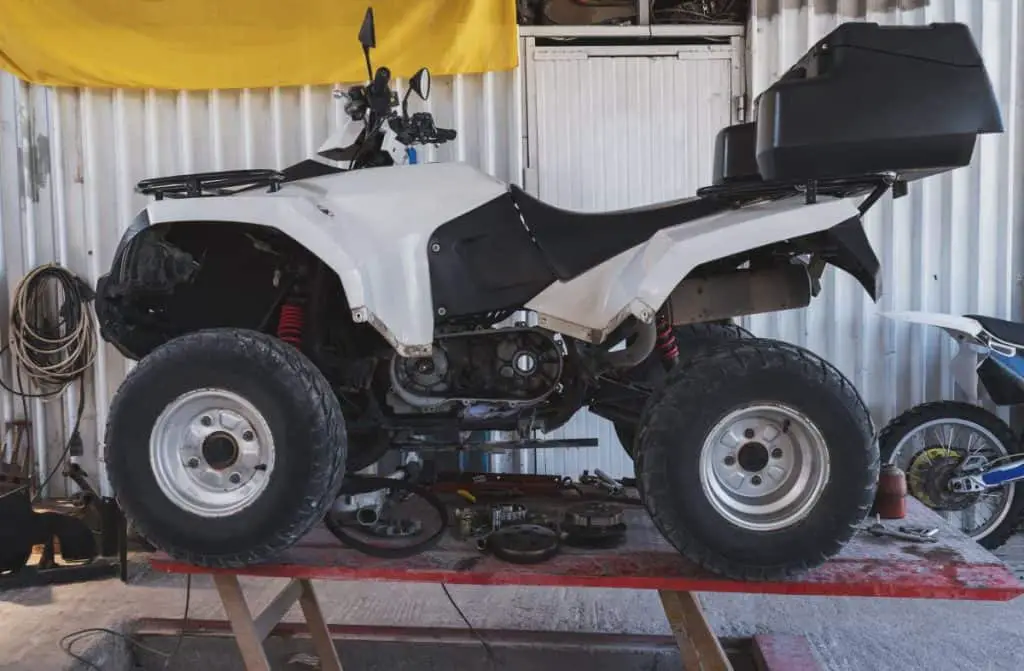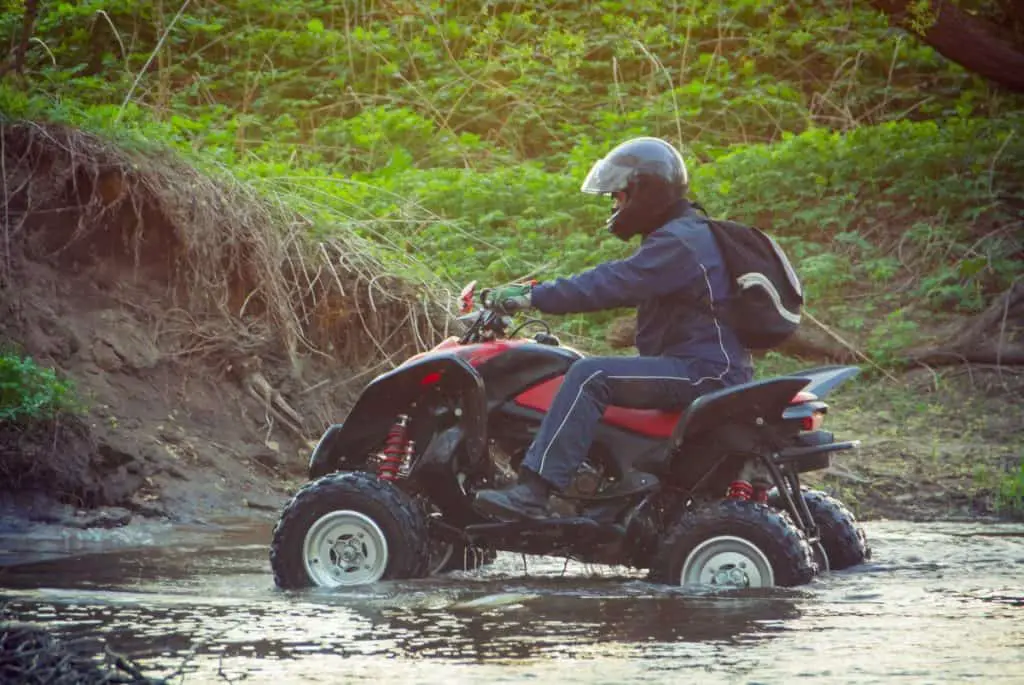There are various warning signs that an ATV transmission needs to be repaired. It can begin to have a chattery feel to it, you can experience gear slippage, or it otherwise just doesn’t feel right. In this article, I will cover step by step how to repair a Honda ATV transmission.
In general, you want to inspect the clutch pack. Measure the thickness of each of the steel plates and fiber plates to see if they’re to spec. Replace the clutch pack if necessary. On the inner hub and outer basket you want to look for grooving, additional steps are outlined below.
There are a few more steps to repairing a Honda ATV transmission. Below, I will provide step-by-step details about performing these, and all the steps involved in repairing a Honda ATV transmission.

Each Step Required To Repair a Honda ATV Transmission
There are 5 major steps to repairing a Honda ATV transmission. Once, you do it once it’s very simple and easy to do yourself. Honda recommends inspecting and doing any necessary repairs on your transmission after the first 20 hours, or 100 miles, whichever comes first. And do it every 100 hours, or 600 miles, whichever comes first.
It’s very helpful to have your Honda ATV service manual on hand. They have diagrams and metrics for your transmission. Refer to this page on the official Honda website where you can put in your make and model, and it will bring up an online version of your owner’s manual. But, I’ll also include a video so you can see what you need to do.
The steps involved are:
- Removing the connections and removing the front cover
- Inspecting the clutch pack, and replacing them if required
- Inspec the hub basket, inner plate, and pressure plate and replace any parts that require it.
- Clean any residue off the gasket
- Reinstall the clutch pack or a brand new one, or some of the plates
Following these steps, I will explain if aftermarket parts void the warranty, how to extend the life of your ATV transmission, and if it’s best to repair your ATV transmission yourself.
The first step is to disconnect each of the connections that go into the transmission. And remove the front cover.
Removing the connections and the front cover
Before, removing the connections and the front cover is a great time to do an oil change. When you do that leave the oil out of your ATV while you repair your transmission. You may have done an oil change somewhat recently.
If you have then prop up your ATV so that the side of the ATV is higher. This can be done by placing blocks underneath both wheels. This will cause the oil to drain away from the transmission.
The things that need to be adjusted/moved out of the way are:
- The transmission cable – needs to be loosened
- The brake pedal needs to be moved out of the way
- The clutch cable, and the clutch cable bracket – need to be removed
- The oil supply line and return line – needs to be disconnected
- The clutch cover – needs to be removed
Here’s a really good video that shows how to do each of these steps:
Inspecting and replacing the steel plates and fiber plates
The steel plates and fiber plates are a set of circular disks. Over time they can get worn. The steel plates and fiber plates make up what is called a ‘clutch pack’. Each of the plates has a specific thickness they should be. They can also get dirty. The measurements for how thick the plates should be is listed in your ATV service manual.
These need to be measured using a ruler, tape, measure, or a caliper. Take a measurement in multiple places. The same thing needs to be done for the steel plates, and the fiber plates. But, the steel plates need to be measured to see if they’re flat. This can be done by placing them on a flat surface and visually inspecting them to see if they don’t lay completely flat.
The plates that make up the clutch pack are reasonably inexpensive, so if need be just replace them.
Take a look at the hub basket, inner plate, and pressure plate
Each of these areas of your Honda ATV transmission can have wear and tear. Wear and tear takes the form of grooves. There can be grooves along the outer edge of the pressure plate. It should be perfectly smooth. If it has grooves carved into it through wear are tear, you should replace your pressure plate.
The inner hub and outer basket can also have grooves that are caused by the plates moving in and out. The plates move in and out when you engage the clutch. As the oil gets dirtier it can increase wear and tear. Also, over time there is normal wear and tear that will cause grooves to form.
When the grooves become quite pronounced the plates don’t grip well. And has the effect of making it very difficult to pull the clutch in. If there are grooves, you should replace the parts that are affected, either the hub basket and/or the hub basket.

Clean any residue off the gasket
The gasket is the area around the rim of your transmission where the cover fits onto the transmission. It can accumulate debris through normal use. The best way to clean them is to use a razor blade and some contact cleaner.
Be careful when using a razor blade not to scour any marks into the gasket. Provided, you use the razor blade at a 45-degree angle, and keep it flat against the surface as you’re scraping off any residue you won’t damage the gasket.
After doing that, use contact cleaner and a rag to wipe down both sides of the gasket.
Reinstall the clutch pack or install a new one
Before installing the clutch pack you should soak them in oil overnight. This should be the same oil. Once you’re ready to install or reinstall them place a fiber plate first, then install a steel plate, and then a fiber plate. Do this alternating pattern until all of the plates have been installed.
You’re now ready to do everything you did to open your transmission but in reverse. This involves:
- Installing the pressure plate over the clutch pack
- Installing the gasket
- Installing the clutch cable
- Installing the oil line
- Install the brake pedal
- Readjust the clutch lever
If you’re unsure about any of these steps refer to the video above, which shows how to do each of them. Although this should be done at the mileage or hours covered in the owner’s manual there are also some signs that your ATV clutch is bad, and needs to be repaired or replaced. I explain what these are in this article about how to tell if your ATV clutch is bad.
Whether you need to use Honda branded parts
Using aftermarket parts does not specifically void the warranty. However, if you made a mistake when doing the repair yourself, and it lead to another part failure, the repair of the part that failed won’t be covered by the warranty. The warranty only covers parts that fail early, as a result of a defective part (source).
The good news is Honda is rated as the most reliable ATV brand, based on an independent survey. To know what specs the different components need to be such as the clutch pack, refer to the specs in your owner’s manual.
Is it better to repair a Honda ATV transmission yourself
In general, this depends on your level of skill at working with tools. For example, if you can do an oil change yourself, you’ll be skilled enough to change a transmission yourself. But, it’s important to follow the guide shown in the video above.
There are minor things that are important to do, such as the way you take off and put the bolts back on. But, other than that it doesn’t require any special skill. The main things are whether you have enough time and the tools to do it yourself.
How to make your ATV transmission last as long as possible
Aim to come to a complete stop only when absolutely necessary. When you stop you need to start up again, which produces more wear on the clutch. Another thing to do is what is called ‘double clutching’. This is where you rev the engine slightly before engaging the clutch. However, this isn’t necessary if you have a newer Honda ATV as they have what’s called a dual-clutch transmission (DCT).

Is Honda ATV Automatic Transmission
It’s common for ATVs to have either manual or automatic transmission. Automatic and manual transmission both have their pros and cons. But, what kind of transmission do Honda ATVs have?
In general, they have the ability to switch between an automatic transmission or a manual transmission. This is built into Honda ATVs. To change it you flip a switch to change it from manual to automatic. Manual is preferred for certain types of terrain and is preferred by some people.
This does, however, depend on the make and model. Newer Honda ATVs have both automatic and manual transmission and the ability to choose which one you want to use at any given time. But, older Honda ATVs, for example, one that you’re buying second-hand can be one or the other.
They can be either a manual transmission or an automatic transmission. They can also have an electric shift. This is a manual transmission but you don’t need to press the clutch. Instead, you press a button to change the gear up or down. Then the internal computer engages the clutch automatically.
How Does Honda Electric Shift Work
A manual transmission on a vehicle requires you to manually engage the clutch. But, there are vehicles where the clutch is engaged automatically when you switch gears. Honda ATVs have what is called electric shift, so here’s how it works.
Overall, the gear is changed without needing to engage the clutch. Instead, you press the up or down buttons on the left handlebar to change gears. Modern Honda ATVs also have two settings it can be set to automatic or manual. When set to automatic the gears shift automatically.
In the same way as an automatic transmission on a car. This is a unique innovation created by Honda, in response to requests from customers that asked for this feature. But, an electric shift is fairly universal and many ATV brands have it. If you’re interested in how ATV brands compare I did a full analysis of the top ATV brands based on a range of metrics. You can see the results in this article about how the ATV brands compare to each other.
What Is Honda ATV DCT Transmission?
Honda ATVs have what is called a dual-clutch transmission (DCT). It was created by Honda, and it’s not really clear what it is, because it’s quite unique. Here’s a summary of what a Honda DCT transmission is.
In general, it has 2 gears engaged at the same time. Therefore, the transition from one gear to the next is much smoother. It uses two independent clutches. One is the gear the ATV is in, and the other is the other gear. When you change the gears the transmission goes from one clutch to the next.
It also has two different settings. It can be set to automatic which works in exactly the same way as the automatic transmission on a car. But, it can also be set to manual, where you can change the gears yourself. This is much better for certain terrains. For example, going up a hill or over very bumpy terrain. That way you can keep it in one gear to make it far easier to ride.
Here’s a video where a Honda technician explains how the Honda DCT transmission works, and why it was created:
